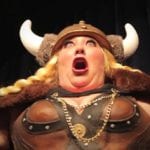 Crime
Crime  Crime
Crime  Technology
Technology 10 Hilariously Over-Engineered Solutions to Simple Problems
 Miscellaneous
Miscellaneous 10 Ironic News Stories Straight out of an Alanis Morissette Song
 Politics
Politics 10 Lesser-Known Far-Right Groups of the 21st Century
 History
History Ten Revealing Facts about Daily Domestic Life in the Old West
 Weird Stuff
Weird Stuff 10 Everyday Products Surprisingly Made by Inmates
 Movies and TV
Movies and TV 10 Actors Dragged out of Retirement for One Key Role
 Creepy
Creepy 10 Lesser-Known Shapeshifter Legends from Around the World
 Animals
Animals 10 Amazing Animal Tales from the Ancient World
 Gaming
Gaming 10 Game Characters Everyone Hated Playing
 Crime
Crime 10 Terrifying Serial Killers from Centuries Ago
 Technology
Technology 10 Hilariously Over-Engineered Solutions to Simple Problems
 Miscellaneous
Miscellaneous 10 Ironic News Stories Straight out of an Alanis Morissette Song
Who's Behind Listverse?

Jamie Frater
Head Editor
Jamie founded Listverse due to an insatiable desire to share fascinating, obscure, and bizarre facts. He has been a guest speaker on numerous national radio and television stations and is a five time published author.
More About Us Politics
Politics 10 Lesser-Known Far-Right Groups of the 21st Century
 History
History Ten Revealing Facts about Daily Domestic Life in the Old West
 Weird Stuff
Weird Stuff 10 Everyday Products Surprisingly Made by Inmates
 Movies and TV
Movies and TV 10 Actors Dragged out of Retirement for One Key Role
 Creepy
Creepy 10 Lesser-Known Shapeshifter Legends from Around the World
 Animals
Animals 10 Amazing Animal Tales from the Ancient World
 Gaming
Gaming 10 Game Characters Everyone Hated Playing
10 Creatures from Harry Potter That Have Their Origins in Myth
The world of Harry Potter has captured the imagination of fans for a variety of reasons, not least the incredibly diverse number of creatures, plants, and supernatural entities which lead to a rich and beloved fantasy world. While some of these are familiar to many of us from a number of different sources, here are ten examples of those who have their origins in myth and folklore from around the world.
Related: 10 Interesting Secrets In Harry Potter
10 Mandrake
The famous mandrake root, introduced in Harry Potter and the Chamber of Secrets is a plant that not only screams when it is being repotted but is also a “powerful restorative” used to treat those who have been cursed, transfigured, or petrified. While the screams of the mandrake can, in some cases, be fatal, those of the younger plants only result in causing unconsciousness.
In reality, the Mandragora officinarum is not only interesting for the shape of its roots, which frequently resemble human figures, but also for its hallucinogenic and hypnotic effects. The combination of these factors makes it unsurprising that a wealth of legends have surrounded this particular plant that predates the Bible.
While in Genesis, the plant is reputed to have cured Racheal’s infertility (Genesis 30:14-17), the later writings of Josephus of Jerusalem (c. AD 37-100) describe the mandrake in a much more recognizable fashion for the fans of J.K. Rowling’s infamous series. To ensure the mandrake’s scream doesn’t kill when dug up, Josephus describes digging a furrow to expose part of the root before being tied to a dog that will then excavate the root and also perish in its master’s place.
Mentioned in the writings of famous occultists Eliphas Levi and Jean-Baptise Pitois, it was later seen as a key ingredient in flying ointments used by medieval witches to attend gatherings or meet with the Devil himself. [1]
9 Dragons
Some of the earliest dragon myths date back to sources such as the Indian Rig Veda (c. 1500 BC), which recounts the release of heavenly waters to the earth following the death of the great dragon Vrtra by the god Indra. Similarly, the Mesopotamian god Marduk battled the dragon Tiamat for control of humanity.
Something more recognizable to us can be found in the Iranian Zoroastrian tradition, which talks of the serpentine “azi,” described as poisonous beings that swallowed both horses and men. And once we reach the 10th and 11th centuries, the Persian Book of Kings recounts the feats of mighty heroes such as Rustum, who frequently found himself pitted against the mighty beasts. Indeed, the idea of the serpentine monster appears throughout various world mythologies: The afore-mentioned Tiamat, the Judeo-Christian Leviathan, the Hydra of Greek myth, and the Norse Jormungandr, the latter of which had a clear influence on the epic Old English poem Beowulf, where we can see the word “dracan.”
More modern depictions of dragons often draw inspiration from these tales, portraying brutal and jealous defenders of their hoarded treasure. However, it is possible that the heraldic use of the dragon has led to the traits of high intellect as well as a benevolent protector and friend to humans in many stories.[2]
8 Pixies
Cornish Pixies, as chronicled by Rowling, are small, blue troublemakers. Traditionally, they are described as often mischievous beings that were frequently the reason for people becoming lost when traveling. Myths of pixies are not exclusive to Cornwall but also appear in Devon, Dorset, and Hampshire.
Pixies are reputedly fond of dancing and gathering together in large groups to play, cavort, or wrestle at night, such as the gathering of 600 at Trevose Head, where the celebrations were cut short when the pixie Omafra lost his laugh. Thankfully for Omfra, King Arthur was able to restore his laughter, and he returned to his pixie queen, Joan the Wad.
The pixies of Dartmoor are incredibly small and friendly. However, they do have a penchant for disguising themselves as rags in order to entice children to play. They may even help with the housework, but if you are traveling and become “pixy-led,” it may be wise to turn your coat inside out in order to find your way once more.
Far from benign, It is sometimes said that the pixies are, in fact, wandering pagan souls, stuck forever in limbo, or even the unbaptized souls of babies.[3]
7 Boggarts
The boggart familiar to fans of the Harry Potter series bears little similarity to their mythological namesake.
With their origins in English folklore, the boggart gets its name from the Welsh “bwg” and, much like pixies, is described as being a mischievous trickster, though with a more malevolent streak.
While its origin was as a hearth-spirit, a boggart is actually a transformation of the usually helpful hobgoblin. If mistreated, it will become a boggart. Its mischievous nature will be present when becoming frightening or even dangerous as it seeks to punish those who have offended or abused it.
Boggarts are often blamed for objects disappearing, milk souring, or even dogs becoming lame. Those who dwell in swamps or marshlands have been reputed to be the cause of missing children.
In the story of “The Farmer and the Devil,” we see that even with all his cunning, a boggart can be bested. Though, let’s hope the farmer in the tale didn’t meet the wrath of Owd Hob, the Lancashire boggart king! Incidentally, those bumps in the night may just be a boggart, more commonly known nowadays as Bogey or the Bogeyman.[4]
6 Basilisk
Another creature that differs greatly from the description given in the Potter books is the basilisk. While said to be the king of the snakes, its huge size is not reflected in the source material: Pliny the Elder writes in his Naturalis Historia that the basilisk of Cyrene is a small snake of “not more than twelve fingers in length.” It is the most poisonous of snakes, with its poison able to flow up the shaft of a spear or lance to kill both horse and rider. With venom and poisonous skin, the serpent was also said to be able to kill with a glare, turning its attention on herbs and plants if humans were not at hand.
Luckily, the odor of a weasel is all you need to repel this nightmarish creature, a legend that may have its roots in stories of the king cobra, whose natural predator is the mongoose.[5]
5 Centaur
The centaurs of J.K. Rowling’s creation share much with C.S. Lewis’s Narnian counterparts. Healing, prophecy, and stargazing become healing, archery, and astrology in the Potter canon. While they are noble creatures, Rowling does not eschew the savagery of the original Greek myths. Wild and untamed, the centaurs are birthed by the union of Ixion and Nyphele and often are representative of the duality of human nature.
While centaurs are generally depicted as male, there have been some descriptions of centaurides, or female centaurs, with a 4th-century mosaic from Tunisia. Also, there is a mention by Ovid of a centauride named Hylonome who committed suicide following the death of her husband.[6]
4 Yeti
Gilderoy Lockhart is said to have spent a “Year With the Yeti” in The Chamber of Secrets, which is not surprising when muggle sightings of the infamous beast have been plentiful. However, the legend of the Yeti dates back to ancient Himalayan folklore, and tales of the creature have been spread by travelers for time immemorial. Indeed, following the conquering of the Indus Valley in 326 BC, Alexander the Great demanded to see a Yeti, although he was disappointed when informed that they could not survive at such a low altitude.
Much like purported sightings of Bigfoot or the Loch Ness Monster, little solid evidence has been presented for the existence of the creature. The famed Sir Edmund Hilary—the first man to scale Mount Everest—found what he believed to be a Yeti scalp, though it later proved to be nothing more than a serow hide, a creature similar to a goat and native to the region.
What better person to have hunted the Yeti than the great Brian Blessed? The actor/explorer has not only scaled mountains and faced off against polar bears but has published a book on his hunt for the elusive giant. If there’s anyone out there that could coax one out, I’m sure it’s the man who has been known to talk of how much female gorillas like him! [7]
3 Elves
Elves have a long and storied history, though none of them are the servile, meek beings found in Harry Potter.
First appearing in Old English and Norse texts, elves are indeed magical creatures and are usually described as either being possessed of incredibly long lifespans or, in some cases, immortal. Being of diminutive stature in the English and Scottish traditions, elves are often elusive, childlike, and, at times, troublesome and mischievous. Although they are not inherently evil, much of the folklore of this time recounts humans journeying to Elphame, often described as unsettling and ghostly. It’s also not unknown for elves to antagonize or even kill humans in certain circumstances.
In Norse tradition, elves are of a more human height and are even able to procreate with humans. Despite this, the alfar, as they are known, were not bound by physical laws and could pass through walls. Elves were more beautiful than humans, though men could ascend to elfhood—if worthy enough.
Yet not all elves are equal: while Freyr reigned over Alfheimr, the land of the light elves, the dark elves dwelt in Svartalfheimr, where they hid from the light of the sun, lest they be turned to stone. These dark elves were the cause of nightmares. So much so that there is even an explanation for sleep paralysis in the form of dark elves sitting on a sleeping person’s chest in the form of a mare.[8]
2 Sphinx
The sphinx, as depicted in The Goblet of Fire, fulfills much the same role as her namesake in the myth of Oedipus, presenting our hero with a riddle that will result in his death if answered incorrectly. Depictions of the sphinx in the Egyptian tradition show a woman’s face, a lion’s haunches, and the wings of a bird. This differs from the description given in Goblet—a large leonine body with a human head.
Due to the riddles of legend, the sphinx became the symbol of not only intelligence and knowledge but also omniscience. Subsequent depictions of the sphinx, such as the Great Sphinx of Giza, are believed to show the faces of pharaohs. In this particular case, pharaoh Khafre, the pharaoh also responsible for the Great Pyramid at the same location.[9]
1 Werewolves
Legends of the werewolf date back to the earliest known example of prosaic western literature; in The Epic of Gilgamesh, our titular hero refuses a potential lover as she had turned a previous lover into a wolf.
Greek mythology also features early depictions of werewolves: Lycaon serves the god Zeus a meal made of a sacrificed boy. In his anger, Zeus transformed Lycaon and his sons into wolves—hence the term lycanthropy.
Tales of transformation into wolves thanks to magical wolf pelts feature in the Nordic sagas. However, far more gruesome are the acts perpetrated by historical figures such as Pierre Bergut and Michel Verdun. They were purported to have sworn allegiance to the Devil and be in possession of an ointment that could to turn them into wolves. These two were burned at the stake after confessing to the murder of multiple children. Similarly, sixteenth-century Frenchman Giles Garnier was also burned at the stake after allegedly transforming into a wolf and killing and eating children.
One of the most famous real-life cases is that of Peter Stubbe, a wealthy farmer in Bedburg, Germany. After children’s disappearances in the area, he was cornered by a group of hunters who claimed to have witnessed him shapeshifting. He later confessed under torture, though while these events may have stoked rampant fears of werewolf activity around Europe, some did not believe in his guilt and thought him to be a victim of a witch-hunt. Perhaps it was more of a case of a scapegoat in wolf’s clothing.[10]








